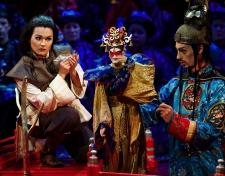Two thousand kids gasped and laughed at simple hand shadows during the first half of the Canadian Opera Company’s production of The Nightingale and Other Short Fables by Igor Stravinsky. There were no actual children that I could see in the audience at the Four Seasons Centre but director Robert Lepage’s magical theatrics reawakened childlike wonder and imagination in the adults attending the second night performance.
It’s pointless trying to describe how a team of acrobats rendered in shadows cooing babies, flying birds and all manner of adorable and precocious cats (Stravinsky loved cats). This was live theatre at its best: You had to be there. Lepage’s inventive use of puppetry elicited the “oohs” and “ahs” that usually greet fantastical feats of technology and design. Instead of applauding the sets, however, the audience applauded itself. With such simple stage craft audiences are that much more engaged in the story because our eyes and brains are fast at work completing the pictures on stage, breathing life into two-dimensional creations. We were actively participating in the drama on stage.
And what strange drama these weird, enigmatic fables had to tell: a topsy-turvy world where “a fish walked out of Novorogod,” a forget-me-not pined for a lascivious dove and a fox used religion to woo a rooster down from its perch so she could eat it.
The second half of the program was comprised of the short opera The Nightingale. Loosely based on a fairytale by Hans Christian Anderson, it’s the story of a songbird that beguiles Death with her song, saving the life of the Emperor of China. It’s lesson? That we can’t possess a song or the beauty of a moment; really living — life — means being open to simple beauty like birdsong.
Stravinsky started composing The Nightingale in 1907 or ’08 but only completed it in 1914. In the interim he had composed three startling ballets, The Firebird, Petrouchka and The Rite of Spring, the latter an epoch-defining work of the 20th century. Both Stravinsky’s Romantic and avant-garde styles are heard in The Nightingale; the first part of the COC program charts this stylistic shift.
Set designer Carl Fillion confronted audiences walking into the main hall with the startling sight (and smell) of a giant pool where the orchestra pit should be — one of those horizonless pools where water rises right to the brim and spills out over the edges. At either side were two wooden platforms: from one sprung a large tree, just above the other hung a large red Chinese lantern.
A 28-member ensemble from the orchestra was arrayed behind the pool (where the lip of the stage would normally be). In what seemed like a playful inside joke, the platform for conductor Jonathan Darlington jutted out into the pool. Only after he took his position did a stagehand place down the podium, effectively trapping Darlington on his little peninsula. Would he walk on water?
His movements caused ripples in the water; projected coloured light reflected off the pool onto a large scrim upstage: undulating blue, then blood red. As soon as he lifted his baton and the first title was projected onto the scrim written in Russian Cyrillic script, the production flagged that this would be a journey into the other.
Except for the Two Poems of Constantin Balmont (from 1911) all the short works were written during World War I when Stravinsky was living Switzerland, cut off from Russia, homesick. The opening instrumental piece Ragtime (1918) confounded expectations, all country jangle with that most Russian zither-like sound from an instrument called a cimbalom. It was an exotic mix of traditional peasant song and bouncy jazz — think Weimar cabaret but in a tent somewhere on the Russian steppes. The next piece, the first of three haunting clarinet solos sensitively played by Ross Edwards, pared down this peasant jazz even further, minimalist but evocative.
The range of selections allowed us to hear how Stravinsky took both late-Romantic music and traditional Russian songs and turned them inside out. The text for Four Russian Peasant Songs (1917), for example, came from a published collection of traditional folk verse but not the music. Only one of these compositions was based on a traditional song yet they all still sounded folksy, “peasanty,” while simultaneously exhibiting that vibrant austerity and rhythmical sophistication that would mark his later output.
Spiritedly performed by female soloists from the chorus — sopranos Simone Osborne and Teiya Kasahara and contralto Maria Radner — these opening songs were a wonder. I was really drawn to Pribaoutki (which can be translated as Limericks) sung by Osborne. The nonsensical text pointed to some earthy, sardonic peasant wisdom that remained teasingly out of reach.
With ever-inventive puppet shenanigans, Lepage, along with puppet designer Michael Curry and puppet choreographer Martin Genest, tricked the audience to sit through a rather rarefied art song program and think of it as the gayest night on the town.
The puppetry got athletic with the dance piece The Fox. Cutouts combined with contorted silhouettes of the acrobats were used as both black and white shadow puppets (with light projected from the back for black shadows and light from the front for white shadows). The acrobats were also partially visible because the scrim didn’t come all the way down to the staging area.
Off to one side were four delightful singers — tenors Adam Luther and Lothar Odinius and baritones Peter Barrett and Robert Pomakov — who traded characters back and forth with a robust jocularity, always capturing the absurd whimsy of the piece and the devilish humour of its antihero.
The full orchestra was on stage for the second half of the evening, The Nightingale, as were the chorus, dressed in blue silk robes of a Chinese court, holding little puppet versions of themselves. The soloists (except Nightingale) emerged in full costume and makeup (by designer Mara Gottler) waste deep in water from under the wooden platforms operating their Bunraku puppets (three-dimensional puppets about 30 inches tall) in the pool.
Whether the lush Debussy-sounding forest scene, foggy and evocative (specially with the sound of lapping water from the pool), the orientalist splendour of the “Marche Chinoise” or the brutal clanging of the mechanical bird scene, the COC orchestra consistently captured the shifting tones and spare melodies of Stravinsky’s score.
As The Nightingale soprano Olga Peretyatko delivered her beguiling song, constantly rising and falling, in a clear and pretty tone. She looked pretty, too, dressed as a peasant girl, often holding in her hand a little toy bird (representing her character) that would flutter high above stage only to land back in her hand moments later. She’d watch both the action on stage and her miniature self with an endearing simplicity, at times quizzical, never pained, seemingly always ready to break into beautiful song.
Another standout in the strong ensemble was Odinius who, as the Fisherman, is unfailingly enraptured by the Nightingale. It was easy for audiences to transfer Odinius’s expressive face and singing to his puppet.
There are some high-fangled discussions of how, inspired by Japanese woodcuts, Stravinsky used a tonal approach to reflect that two-dimensional imagery. So when the shadow puppets of the first half gave way to three-dimensional puppets in the second half, it was a clever reflection of the passage of time — that other dimension — which had such a profound effect on the composition of The Nightingale.
Like the symbolist painters and artists who inspired him in Paris, Stravinsky loved artistic alchemy. Whether folk music, an invented Orient, western classic music from a broad range of time periods or the serialist innovations of the 20th century, Stravinksy, over his long career, deconstructed and reassembled every genre and style of music that inspired him and made them his own — he was very modern that way.
In charting the first fateful steps in Stravinsky’s ever-changing musical evolution, this amazing COC production propelled us on a magical journey through time and space, across 19th-century Russia and its newly acquired Asian empire to an imagined Far East. It’s a journey into the (can I say demented?) Russian soul — only a Russian émigré could recognize that the other is our self.


 Why you can trust Xtra
Why you can trust Xtra


